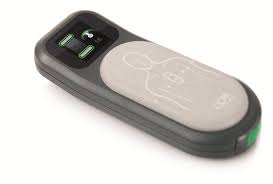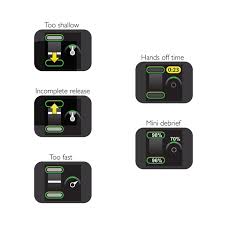How can you be absolutely sure your chest compressions are effective?
CPRmeter™ – a tool for training, a tool to help save lives
When students attend CPR training at CPR Seattle, at some point the instructor will assess their chest compression speed, depth and recoil to make sure AHA guidelines are met. Usually this is done by using a timing device, audible feedback from the mannequin, and visual observation. This is a requirement of the American Heart Association that ensures each person understand (and most importantly, can perform) effective CPR. With CPR chest compressions, being able to quantify the quality of the practice can lead to better retention and confidence on the part of the student. This is why CPR Seattle has employed the latest technology to effectively and decisively evaluate student performance.
 The CPRmeter™, developed by Laerdal Medical, is a device used both for practicing chest compressions and for administering them to actual cardiac arrest victims. The device is embedded with two sensors, one to measure force and one to measure acceleration. This allows for objective measuring of compression depth, recoil, and rate, as well as keeping track of how many compressions have been given. Warning symbols direct the rescuer to correct and improve their chest compressions as they administered, thus allowing CPR to continue uninterrupted.
The CPRmeter™, developed by Laerdal Medical, is a device used both for practicing chest compressions and for administering them to actual cardiac arrest victims. The device is embedded with two sensors, one to measure force and one to measure acceleration. This allows for objective measuring of compression depth, recoil, and rate, as well as keeping track of how many compressions have been given. Warning symbols direct the rescuer to correct and improve their chest compressions as they administered, thus allowing CPR to continue uninterrupted.
The CPRmeter™ is being used by CPR Seattle in all classes, but with an emphasis on the BLS/CPR for Healthcare Providers curriculum, as it are those students who require more intensive CPR training.
After the CPRmeter™ is employed, the rescuer/student can review the CPR performance via the device. The display indicates the percentage of compressions with adequate recoil, the percentage with correct depth, and the percentage performed at the correct rate. A summary will also show how long the CPR event lasted and the percentage of time when chest compressions were being delivered. This allows for quantitative review of the event and ensures that the provider is aware of what improvements in technique may be required.
As healthcare technology continues to innovate, so must training. CPR Seattle wants to ensure that each of our students is well-prepared for these coming developments, and the in-class use of the CPRmeter™ helps to keep our training programs moving in the right direction.
Enjoy our blog? follow us on Facebook.
Published on November 3, 2015
